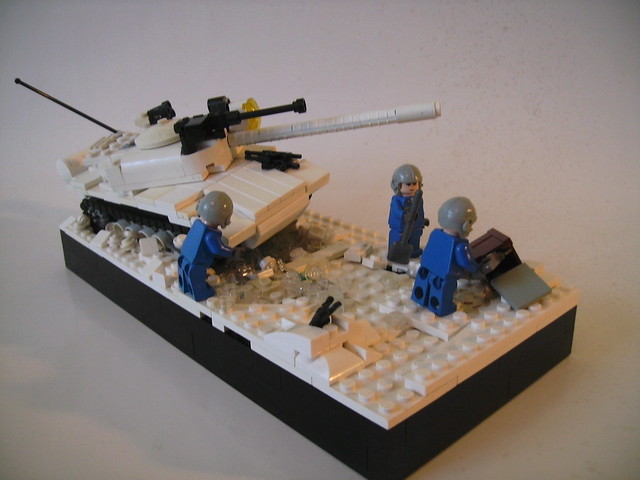
Saturday 30 October 2010
Trapped Under Ice

Friday 22 October 2010
LMM Interview: Aleksander Stein
LMM is happy to bring to you its very first interview! Who better to start with than everyone's favorite long-haired Viking?
Aleksander Stein should need little introduction for anyone who has been following the military building community for the past three years. His military vehicles have been the envy and inspiration for military MOCers; and he's probably also among the military builders to receive most recognition in the online community in general. His MOCs have won awards in the Flickr Military Competitions every year, and he's even been commissioned by the Norwegian Army to render some of their newest hardware in brick.
Aleks was gracious enough to join us for a lengthy interview, where we talked military faction development, some of his favorite builds, and much else besides.
Hello, Aleks thanks for joining us. Tell us a little about yourself.
Well, I'm 23 years old, and was born on the anniversary of Norwegian liberation in 1945. I'm currently studying architecture at the Oslo School of Architecture and Design. I'm an '80s music aficionado, a dedicated music collector, and a "dedicated-yet-not-that-skilled" guitar player. I also love old-school TV-series, and a bowl of breakfast cereal is never complete without an episode of Magnum P.I.
Oh, and I build some Lego stuff too.
You've become one of the big names in the military theme, yet as I recall you only started building a few years ago. Did you come out of a dark age, and how did you find yourself building military stuff?
Lego has been a part of my life for as long as I can remember actually, but I did go through sort of a "grey age" during my teen years. While I never stopped building completely, the things I did build were few and far between. When I finally picked up on my old hobby again full time, I settled on the military theme mostly because I've always been interested in military vehicles and 20th century military history. I had also been collecting military display models for some time (which I still do), so combining these interests with my Lego habit just seemed like a natural thing to do.
You have an interesting mix of MOCs that you've designed completely yourself, and what I can only describe as "personally-modified-models-of-actual-military-hardware". How did this blend of modelling and "freebuilding" develop?
Even though I build models of fictional hardware, I always try to make it look as realistic as possible – as if my vehicles could actually have existed. I'm always impressed by all the great real-life models people out there build, and the skill and effort that goes into each one. However, I prefer to add my own personal touch to the stuff I build. Inspiration may also come from more than one specific vehicle, and several of my fictional models have borrowed features from a variety of their real-life equivalents. This blend of modelling and freebuilding gives me enough freedom to do my own stuff, but at the same time adding the challenge (and sometimes restraints) of modelling something accurately/realistically.
And how do you decide which to build for any give MOC?
I think that's more of a spur of the moment thing than anything else, but there may be less chance of me making a lot of modifications to a fictional Lego model if it is inspired by a vehicle I really like. For example: my fictional CV-100 Bayonet IFV is not all that different from its real-life equivalent, the CV-90.
Earlier this year you were commissioned to build a model of the ARCHER Artillery System for a artillery unit in the Norwegian Army. How did this come about, and what is this project like for you?
There was a guy in the Artillery Battalion who happened to be an AFOL, and he had stumbled across the pictures of my minifig scale ARCHER Mk. II on Flickr. He contacted me, and asked if I would be interested in doing something similar for the Artillery Battalion. After some discussions with him and later his CO, we settled on a 1/22 scale model of the real ARCHER – about twice the size of the ARCHER I already had built. I must admit, I was a little nervous about this commission at first, especially since I had never tackled a model of this size before; and I didn’t even know exactly how the final production version of the ARCHER looked like! I did get used to building in a larger scale eventually though, and after I got some pictures of the real ARCHER work became a whole lot easier – relatively speaking.
So what was it like building a new ARCHER in a completely different scale?
At first I thought I could use the minifig scale ARCHER I already had as sort of a template for the larger one, but I soon had to scrap that idea. Building a model twice as big required a very different approach, especially due to the increase in weight. The articulated chassis needed to be thoroughly strengthened to prevent the heavy forward section and rear gun turret from drooping. The turret mount also required strengthening in order to handle the heavy pivoting gun turret.
I understand you went out to see an actual ARCHER demonstration - that must have been pretty cool?
Yes indeed, I was permitted to tag along on a demonstration of the real ARCHER at the Army base at Rena in Norway, where they showed the vehicle's features (everything except actually firing a 155mm shell), and a reloading from the ARCHER's support vehicle. I had a great time there, and the Lieutenant that had commissioned the model also showed me around in the base's garage as well. I was like a kid in the candy store.
You also travelled all the way from Norway to Northern Virginia this year for BrickFair 2010. What was this like compared to what you had expected?
It was everything I had expected, and then some. I had some idea of what it would be like from looking at pictures of previous events, but actually being there was really something else. Seeing the stuff on display up close was great fun, as was displaying my own stuff, but the best was the social side of the event - finally meeting up (and goofing around) with a lot of the guys I know from Flickr in person, as well as meeting a bunch of new people. The summer in Northern Virginia is definitely rather different from the summer in Norway though. I think I'll bring a pair of shorts next time!
What surprised you, and what was most memorable?
Heh, well pretty much everything was new to me on that trip, considering that it was my very first time stateside and the first time I attended a large-scale Lego convention. One thing that did surprise me though, was that my every single one of the models I brought survived the flight more or less in one piece. This was the first time I had brought my models with me on a plane, and I was somewhat nervous about their safety on their way across the pond.
Do you have any plans to spend more time with other builders in Norway?
I definitely want to do that, and I hope I will. I had a great time putting up the display together with some of the guys from the Norwegian LUG Brikkelauget in Asker last October, and I would love to do something like that again sometime. The only problem is that I usually have a very busy schedule with long workdays, and taking time off isn’t always easy – if at all possible.
As well as being a terrific build MOC for MOC, you're also on the cutting edge of faction development. You're juggling at least two major factions. How did these develop?
Everything started with the Eurusian Federation really, and the background story I wrote for that when I started posting my Lego creations on the net. In addition to presenting the Eurusian Federation's background, both the Nordic Defence Council (NDC) and the DRR (East Russia) are mentioned in there. I knew I would most likely be expanding into more than one faction eventually, and I thought intertwining them in each other's history would be a nice way to keep my factions knitted together in a (fictional) global perspective. This may seem like overdoing things to some, but as a 20th century history buff, I'm interested in how different superpowers and empires develop and consequently affect each other. Geeky? You bet!
When you started the factions, did you have an idea of how big you wanted them to be?
I knew I wanted to make my factions as comprehensive as possible, and that these would be long-term projects. I also wanted them to be defined, yet still open enough to include a wide selection of both hardware and smaller story segments, which are usually a part of vehicle descriptions and dios. Also, by incorporating ongoing low-intensity conflicts, the story can evolve naturally, without necessarily moving towards a pre-determined ending.

And what about your MOC descriptions - you clearly put a lot of time into getting those just right. You're essentially describing fictional vehicles and military hardware as if they were the real thing. Do you have a big story in the back of your head that you are slowly unveiling, or do you just make it up as you go?
When I'm building I often do a fair bit of research, which naturally involves a bit of reading. This leads to me picking up things here and there, which I later use in a following description of a fictional model. As mentioned, I do strive for a high degree of realism in my work, and I think the descriptions help add to this. I always like to hear about the historical context of vehicles I'm interested in, which is probably why I also enjoy coming up with descriptions for the fictional vehicle models I build, in terms of technical specs, design, purpose, usage etc. In most cases, I make this stuff up as I go along, though I often build on the factions' background stories and/or older descriptions. A good example of this is NDC transition from using the Fenrir LMVs to the newer Wolfhound AMPVs.
What can you tell us about how you see your factions developing?
Hard to say, since I don't have a set plan I’m following. As I've filled most of the slots for key frontline fighting vehicles though (and are pretty happy with those for now), it’s not unlikely that I'll be turning the focus more towards the support role and rear-echelon forces. Some more specialized units are also in the works, such as the NDC "White Bear" winter combat units, and it is high time for me to build another aircraft.
What would your tips be for builders who want to develop Military factions?
First, I would recommend anyone who wants to start up a new faction to do their own thing, solely because you have a lot more room to manoeuvre that way. You’re not tied up by another person's requirements and standards, which can kill the fun of it all really fast.
Second, be patient. You don't have to build everything at once. When you start there will be a lot of vehicle and aircraft types you have yet to build, but it's been like this for every faction builder out there – me included. Build what you have bricks for at the time, and put some real effort into it. Most people out there will enjoy a single well-built vehicle a thousand times more than a dozen rapidly assembled half-assed ones.
Third, it's ultimately what you build that matters! A comprehensive in-depth background story is never a bad thing, but don’t let it keep you from building awesome models, fictional or non-fictional.
Let's hear you evaluate your own work a little now. Which of your builds are your proudest of? Which were the most challenging?
In terms of shaping, I think the EH-191 Whirlwind (in its current revised state) still reigns supreme. The bulbous, yet streamlined shape of most helicopters is usually very hard to get right, and an angled fuselage doesn't make things any easier. I'm also rather happy with my five-bladed rotor solution. Shaping was also the challenge on the hull on the CB-95 Rockfish. That was the first time ever I built a boat hull from scratch, but it turned out rather well I think.
Shaping was also the challenge on the hull on the CB-95 Rockfish. That was the first time ever I built a boat hull from scratch, but it turned out rather well I think.
More recently, I'm somewhat proud of the rotor struts for my Focke-Achgelis Fa-223 WWII model (which was a total pain to get right), and my Patria Xa-380.

Do you find it is much easier building armored vehicles, now that you have built so many?
To some extent, yes, but each new vehicle comes with its own set of challenges. I also try to do something new, or at lest something a little different, for each new vehicle I build, which means I don't always know how to solve every problem from the get-go. Of course, there are a few things that remain the same for each build, like how much room is required to fit a minifig for example.
Are there any of your MOCs that you feel in retrospect you could have done differently?
Hehe, I think those who have been following my photostream on Flickr know the answer to that already. While every model goes through a pretty extensive design process between the prototype and the posting of pictures on Flickr, I do usually end up making modifications to them sooner or later. It's especially the models I have on display at home, because I see them every day. The models that are stored in boxes or shelves out of sight are much less likely to go through major rebuilds. It still happens of course, only with longer intervals.
The main reasons for modifying or rebuilding a model are to improve its looks and/or improve/strengthen its construction. In regards to a model's construction, I may also revise it in order to rationalize and simplify it. This often makes MOCs stronger and also frees up parts, which in turn can be used in new models. This is extra economical for the NDC models, which use rather expensive and rare colours in their camouflage scheme.
Can you give us any teasers about WIPs you have in the works or other fun projects on the horizon?
I'm currently working on a new line of transport trucks for the NDC, called "Atlas", which I displayed a prototype of at BrickFair. That is the only current WIP project that is in the building stage right now, but I do have several other projects lined up on the drawing board.
What are some of your favorite recent military creations by other builders?
Well, perhaps not surprisingly, the collaborative WWII ship display at STEAM springs to mind. But there have been a lot of very nice military creations on Flickr lately. Simon T James has posted some excellent modern British military models, BrickMonkey’s SS-1 Scud TEL is also a definite favourite, Mike Psiaki's latest helicopters are very cool, so are Matt Hacker's Puma IFV (WIP). And ShockAndAwe has built a great looking model of the Stryker MGS. The list goes on, but those were the ones that immediately came to mind.
Tell us a little about your non-military projects - you build civilian farm machinery - that's a pretty quirky specialized niche. How did you get into that?
In addition to military stuff, I’m also quite into the Town (or is it City now?) theme. Though more peaceful, my interest for heavy equipment is still there, so I do enjoy building farm, construction, and industrial equipment. More than anything, it was TLC's new line of farm sets that triggered this rural project of mine, but I think there may also be a little hillbilly deep inside of me somewhere…
Do you have any building tips in general for FOLs who are just getting started with the Military theme?
Pretty much, just have fun! It may sound banal, but that’s really what this hobby is all about – even if you do build high-tech war machines. And do browse Flickr or Brickshelf (or to some degree Mocpages) if you need inspiration for what you'd like to build. There are a lot of experienced military builders out there, which you can get inspiration from. In most cases they also happen to be pretty nice guys, so don't be afraid to ask them a question or two.
Monday 11 October 2010
Arctic build challenge
Tim Ltd started with a great entry called the hedgehog.

He posted two pictures and I like it so much that so will I. So, what do I like about it? First of all, the size. It's no secret that I favour the smaller end of minifig scale and with a width of a mere 12 studs, this vehicle is relatively compact.

The light grey/bley and white camouflage also works well.
If we had a prize for 'most active builder' in this challenge, Snuffwuzz >.<would have won it hands down. He's obviously having a bit of a Russian kick at the moment, producing a T90 Main Battle Tank, BMP-3 Ifantry Fighting Vehicle and BTR-80 wheeled armoured personnel carrier.

![BTR-80A (Russia) [1/31]](http://farm5.static.flickr.com/4150/5036827598_a0f69b50d0.jpg)
![BMP-3 (Russia) [1/31]](http://farm5.static.flickr.com/4146/5026371496_73a11f6854.jpg)
It's a shame LDD doesn't seem to do Technic tracks, because the BMP and T90 do look a bit unfinished without them, but all three are clearly recognisable and the shape and the camouflage are top notch.
BrickMonkey built a vehicle that has been on my wish-list for a long time. (I catually had one years ago, but it was yellow. No tan LEGO yet!). The SS-1, ASCC reporting name 'SCUD', is a tactical ballistic missile originally developed in the Soviet Union and (sadly) widely exported all over the world. It gained particular notoriety during the Gulf War of 1991, when the Iraqi military (under Saddam Hussein) launched versions of the Scud at targets in Israel and Saudi Arabia with almost complete impunity. They were hard to intercept, but they were also hard to destroy on the ground. The missiles could be carried and launched from so-called Transporter-Erector-Launchers. The name says it all. By constantly moving these around, it became almost impossible to track down the launch sites. Fitting for the challenge he's gone with a cool grey exterior for his entry.

He didn't actually build this Arctic version in real bricks, but he has gathered all the parts to build it in the more common desert scheme. This is blogworthy by itself, so I might as well show it here.

Cpl. Custard presents a counterweight to all this Russian-built mayhem in the form of an M1A2 Abrams, also built in LDD so also lacking tracks.

It is based on a custom kit by Tam Antony, but with a few changes to the shape of the front of the turret, added 'reactive' armour and a different colour scheme, obviously. Since I much prefer to see brick-built models than LDD-renders, I suggest you also take a look at the brick built model (largely in tan).
Avalella's C908A1 Longhorn tank shares its colour scheme with the vehicles by Snuffwuzz >.< and Cpl. Custard. It's nice to see it in the bricks (and with tracks).

I'm normally no big fan of custom minifigs, but I do like the crew he's built to go with the vehicle, using some nice-looking stickers made by flickr user Roaglaan.
In his back story Matt Hacker describes how his fictional Lynx Infantry Fighting Vehicle is Canadian-built. I think it looks quite a bit like an American Bradley, and that is not a bad thing at all.

He mentions it's still very much a work-in-progress, but it looks fine to me so far. In addition to his IFV, Matt also built a matching Multi-Purpose vehicle. At a first glance it seemed a bit large to me, but after reading the description it became clear that is is supposed to be a far heavier vehicle than, say, a HumVee.

Aleksander Stein didn't disappoint this month, also building multiple entries. His first entry is an 8-wheeled Infantry Fighting Vehicle, based on the real world Patria AMV. The real vehicle is from Finland, which already gives it an Arctic twist in my book. Aleksander added t that by giving the vehicle a camouflage scheme involving light grey and white, which are colours we've already seen on other vehicles in this challenge, but also a few bits of dark green here and there. It gives them an added realistic touch. Also note how he's built the sides with brick on its side. Very nice.

A similar colour scheme also adorns the arctic version of his regular Wolfhound vehicle

I love the tracks on this in particular.
Chris C (who is from the UK, apparently) submitted an entry that caused some discussion between Magnus, Chandler and I. We are a LEGO group and this model, of a C-130 Hercules, contains a fair few Mega Bloks. So, what to do with this? We weren't sure at first. It is a reasonably nicely sculpted model, though, so we figured we'd let it in.
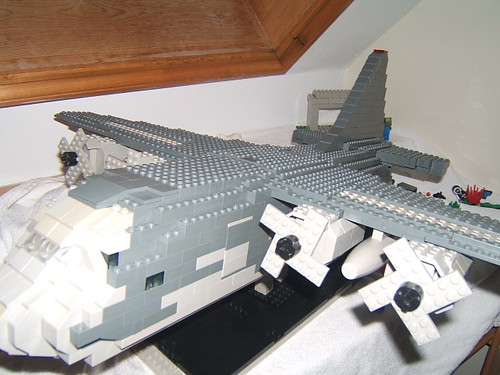
I don't really like the propellors, but the shape of the fuselage, the front and the sponsons for the undercarriage in particular, is nicely done. It also has an interior.
For his first MOC posted on flickr Brickout felt like doing something a little different in this vehicle-heavy challenge. He built a small diorama called the 'Arctic Incident'.

in one of his comments he writes: "you already know the backstory, don't you". Well, no, but I'm guessing it's something from a computer game I don't know. Anyway, it depicts a US Navy seal lying in ambush inside a ruined building, ready to cause havoc to two baddies. There is no single picture that shows the whole scene, so to appreciate the details you'll have to take a look at the whole set.
Brickout wasn't the only person to have the idea of building a diorama. Our very own Chandler Parker has built a historic scene showing German troops captured by the Soviets after the famous battle of Stalingrad. The German army put the city of Stalingrad under siege for several months and had succeeded in capturing parts of the city. However, they were increasingly hampered by fierce winter weather. In February of 1943 the Red Army launched a massive counter-attack and managed to surround the German 6th Army, which ultimately was forced to surrender. The Soviets captured 130,000 PoWs, the majority of which were German. The months of fighting had already caused scores of casualties on all sides, but many German soldiers also perished in captivity.

It was the first major defeat suffered by Nazi Germany.
There were more to follow. On 'D-day', in June 1943 the Western Allies successfully invaded Nazi-occupied France and slowly but surely moved towards Germany. In a desperate attempt to halt the Allied onslaught, the German army launched a counter-attack in the Ardennes region in Belgium in the cold winter of 1944/1945. Due to weather conditions, Allied troops could not count on air support and in particular troops of the 101st Airborne Division in the city of Bastogne had to slug it out against the Germans without support or resupplies for several days.

Phima depicts a wintery scene in which US troops attack a German pillbox during the Battle of Bastogne.
Magnus Lauglo built a vehicle he calls a Snow Cat for this challenge.
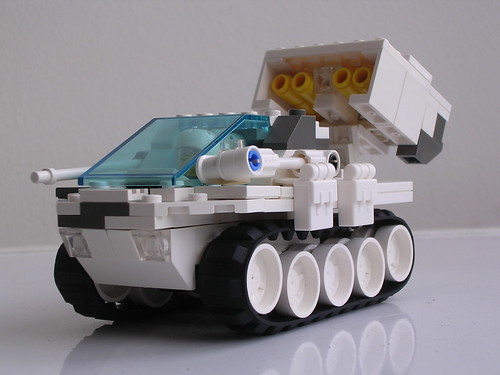
Most of you cats may not remember much from the 'eighties (or weren't even around), but I remember seeing a rather similar vehicle on TV back then. In fact, here's a toy version: the GI Joe Snow Cat.
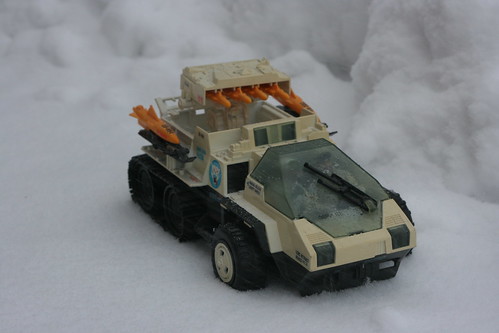
Look familiar? Knowing that Magnus likes a bit of 'GI Joeness' about his models, I don't imagine that the similarities are a coincidence.
Size does matter, but small can be beautiful. The Legonator built three microscale vehicles for this challenge.
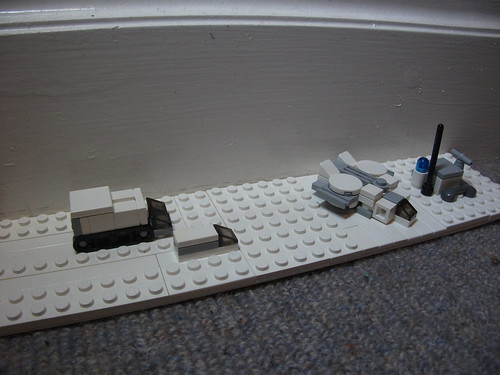
It's a small vehicle, something that does look rather like a science-fiction drop-ship and, my own favourite of the lot, a tracked truck. This works particularly well on this tiny scale.
I'm going to end this write-up with two helicopters. Regular followers of this blog may already know I have a thing for helicopters. Sgt. Gunshow entered his UH-77 Patriot.

According to his description, it's his second attaempt at building a helicopter. I think it could do with some more clearly visible engines, but it's certainly not a bad effort. I like the teeth! I also like the name: the UH-77 Patriot.
I'm going to end this write-up with one of my favourite models to come out of it. That is not to say that I don't like the others, but regular followers of this blog may already know that helicopters aren't the only topic I have a thing for. I also love the models built by Mike Psiaki. So, when he builds a helicopter, it ticks multiple boxes.

It's got all kinds of things I like. It's nicely proportioned and is very detailed. It also includes Mike's brilliant sliding door mechanism, which I highlighted a while ago. I particularly like the rotor hub and it too has a fancy name: the UH-76 Pennacook, which fits nicely in the US Army tradition to name its helicopters after Indian tribes.
I'm not sure it's a coincidence, but we seem to be building a sequence, with the UH-76, UH-77 and the HH-78 Gannet/SH-78 Sea gauntlet. Nice!
Chandler has already introduced our next build challenge: Air Defense. I hope I'll find the time to build something for this myself, but in any case I'm looking forward to what members of the Lego Military Models Group will come up with.
Happy building!
